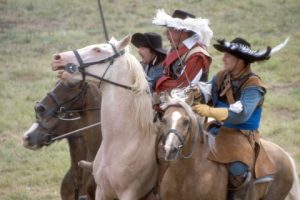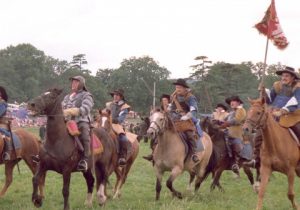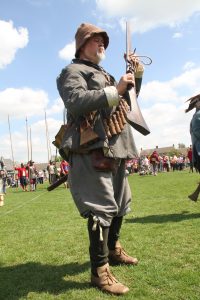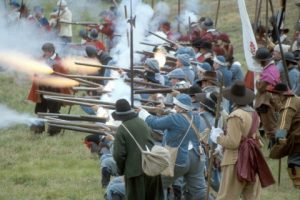This page has a brief description of the types of troops, and their equipment, involved in the Battle of Chalgrove.
“About four in the afternoon his Highness drew out of Oxford, crossing the river Thame at Chiselhampton Bridge. His strength was near 2,000 men whereof about 1,000 were Horse under three Regiments. Of Dragooners marched some 350 and of Foot, there were betwixt 400 and 500 commanded men without Colours. The van of this greater Partee, was a lesser Partee commanded by Sergeant Major Legge with 100 other commanded Horse and some 50 Dragooners. With this little Army, without any Ordnance to slow them or pike to defend them from Horse they headed through the night towards Chinnor.“
Horse is an alternative name for Cavalry. Cavalry officers were taken from the aristocracy and Gentlemen of the highest rank. Troopers were drawn from the sons of lords, clergy and gentlemen of rank. The Royalist cavalry are depicted as dashing ‘Cavaleros’ while Parliament’s troopers are seen as dour all wearing helmets termed ‘lobster pots’. A style taken from Cromwell’s New Model Army.


At the time of Chalgrove troopers’ were recruited from gentlemen who owned a horse. Being gentlemen of the hunt they had the riding skills and equipment to go into battle. Confusion of who was who on the battlefield was partly resolved by the wearing of field signs. In the melee of Parliament’s rout at Chalgrove the Late Beating Up has, ‘now the reason why we killed no more was, partly because diverse of the Rebels had red scarves like ours, and by following them, were Mr. Howard, and Captain Gardner unawares engaged and taken’.
Riders were able to control a horse with their feet while using their hands to fight with a sword and/or pistol.
Cavalry
A sword was the primary weapon for the cavalry officer and/or trooper see here
A brace of pistols as per http://www.militaryheritage.com/pistol5.htm were held in holsters either side of the horse.
The Back and Breast plate armour was proofed for pistol shot at 20 paces (see here). Note the dent of a shot above the hand.
Dragooners
Dragoons were mounted foot soldiers whose purpose on the battlefield was to ride up to the enemy and dismount. The horses were led away to safety while the dragooners in the teeth of the enemy had to fight it out at close quarter or provoke the cavalry into a charge. Hence the term to be dragooned into a dangerous situation. Dragoon horses tended to be cheap beasts of burden such as those shown in ‘Leaving Thame’. They were named after their main weapon, ‘the dragon’, a nick name for a doglock or firelock musket common in the 17th century.


Musketeers
Musketeers were issued with a standard 42 inch matchlock musket.

On the battlefield musketeers fought in organised ‘blocks’.

Five hundred commanded musketeers marched to Chinnor without Colours. Companies of Foot fighting on a battlefield are trained to receive orders through Colours and Drums. Thats why even today we have the Trooping of the Colours on the Sovereigns Birthday. Prince Rupert’s intention of raiding Chinnor with sufficient men to carry away the booty is clear.


